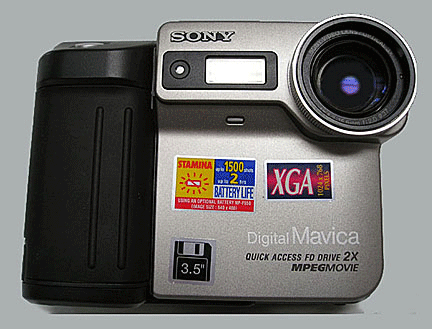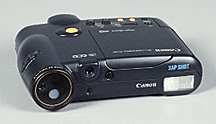
A
BRIEF HISTORY OF DIGITAL PHOTOGRAPHY
 On
October 17, 1969, George Smith and Willard Boyle invented the
charge-coupled device (CCD), the image sensor that’s the heart of all
digital cameras, at Bell Labs. But like many inventions originally
designed for one use, Smith and Boyle were attempting to create a new kind
of semiconductor memory for computers. At the same time they were looking
for a way to develop a solid-state camera for use in video phones. It took
just an hour for them to sketch out the CCD’s basic structure, define
the concept of its operation, and outline the applications for which it
would be best suited.
On
October 17, 1969, George Smith and Willard Boyle invented the
charge-coupled device (CCD), the image sensor that’s the heart of all
digital cameras, at Bell Labs. But like many inventions originally
designed for one use, Smith and Boyle were attempting to create a new kind
of semiconductor memory for computers. At the same time they were looking
for a way to develop a solid-state camera for use in video phones. It took
just an hour for them to sketch out the CCD’s basic structure, define
the concept of its operation, and outline the applications for which it
would be best suited.
By 1970, Smith and Boyle had built the CCD into the world's first
solid-state video camera. In 1975, they demonstrated the first CCD camera
with image quality sharp enough for broadcast television.
Today, CCD technology is pervasive not only in broadcasting but also in
video applications that range from security monitoring to high-definition
television, and from endoscopy to desktop videoconferencing. Facsimile
machines, copying machines, image scanners, digital still cameras, and bar
code readers also have employed CCDs to turn patterns of light into useful
information.
 It wasn’t until 1981, however, that Sony Corporation produced the
first prototype digital camera, the Mavica (Magnetic Video Camera)
electronic still camera, which recorded images as magnetic impulses on a
compact two-inch still-video floppy disk. The images were captured on the
disk by using two CCD (charge-coupled device) chips. One chip stored
luminance information and the other separately recorded the chrominance
information. This camera provided a 720,000-pixel image. The images could
be stored on the floppy disk either in Frame or Field mode. When the
photographer selected the Frame mode, the sensor recorded each picture on
two tracks. Up to 25 images could be recorded on each disk.
It wasn’t until 1981, however, that Sony Corporation produced the
first prototype digital camera, the Mavica (Magnetic Video Camera)
electronic still camera, which recorded images as magnetic impulses on a
compact two-inch still-video floppy disk. The images were captured on the
disk by using two CCD (charge-coupled device) chips. One chip stored
luminance information and the other separately recorded the chrominance
information. This camera provided a 720,000-pixel image. The images could
be stored on the floppy disk either in Frame or Field mode. When the
photographer selected the Frame mode, the sensor recorded each picture on
two tracks. Up to 25 images could be recorded on each disk.
When the photographer selected the Field mode, the camera recorded each
picture on only one track, allowing up to 50 images to be recorded. Images
were less detailed compared to images recorded in the two-track Frame
mode. The MVC-5000 was considered to be the leader in image quality during
its time. This was then put into a video reader that was connected to a
television monitor or color printer. However, the early Mavica cannot be
considered a true digital camera even though it started the digital camera
revolution. It was a video camera that took video freeze-frames.
All this made the Mavica camera a bulky affair that looked more like a
floppy disk box than a traditional camera. But, nevertheless, the race was
on to see who could take this technology to new heights.
 Unlike
traditional cameras that use film to capture and store an image, digital
cameras use a solid-state device called an image sensor. These
fingernail-sized silicon chips contain millions of photosensitive diodes
called photosites. In the brief flickering instant that the shutter is
open, each photosite records the intensity or brightness of the light that
falls on it by accumulating a charge; the more light, the higher the
charge. The brightness recorded by each photosite is then stored as a set
of numbers that can then be used to set the color and brightness of dots
on the screen or ink on the printed page to reconstruct the image.
Unlike
traditional cameras that use film to capture and store an image, digital
cameras use a solid-state device called an image sensor. These
fingernail-sized silicon chips contain millions of photosensitive diodes
called photosites. In the brief flickering instant that the shutter is
open, each photosite records the intensity or brightness of the light that
falls on it by accumulating a charge; the more light, the higher the
charge. The brightness recorded by each photosite is then stored as a set
of numbers that can then be used to set the color and brightness of dots
on the screen or ink on the printed page to reconstruct the image.
In 1986, Kodak scientists invented the world's first megapixel sensor,
capable of recording 1.4 million pixels that could produce a 5x7-inch
digital photo-quality print. In 1987, Kodak released seven products for
recording, storing, manipulating, transmitting and printing electronic
still video images. In 1990, Kodak developed the Photo CD system and
proposed "the first worldwide standard for defining color in the
digital environment of computers and computer peripherals." In 1991,
Kodak released the first professional digital camera system (DCS), aimed
at photojournalists. It was a Nikon F-3 camera equipped by Kodak with a
1.3 megapixel sensor.
 Another
significant model of camera, XapShot was a Hi-band still video camera. The
XapShot had a built-in flash, self-timer, and an unusual rechargeable lead
acid battery. Also required was a kit which included one floppy disk, the
battery, and computer interface card with software. The American version
of the XapShot could send a signal to a TV/VCR for playback and recording
of images. There was also a very basic software utility that worked under
System 6/7 for the Mac in conjuction with the a special video capture card
that the camera connected to. Later, the Xapshot worked with Adobe
Photoshop to capture the images.
Another
significant model of camera, XapShot was a Hi-band still video camera. The
XapShot had a built-in flash, self-timer, and an unusual rechargeable lead
acid battery. Also required was a kit which included one floppy disk, the
battery, and computer interface card with software. The American version
of the XapShot could send a signal to a TV/VCR for playback and recording
of images. There was also a very basic software utility that worked under
System 6/7 for the Mac in conjuction with the a special video capture card
that the camera connected to. Later, the Xapshot worked with Adobe
Photoshop to capture the images.
In 1990, Logitech came out with the Dycam Model 1 black-and-white
digicam, the world's first completely digital consumer camera. It stored
32 compressed images internally using 1MB RAM on a 376 x 240 pixel CCD at
256 shades of gray in TIFF format. This simple camera by today’s
standards had an 8mm fixed-focus lens, standard shutter speeds of 1/30 to
1/1000 second and a built-in flash. The Dycam worked similarly to the
XapShot except that it included the digitizing hardware in the camera
itself. The user had to connect the camera to a PC to transfer images.
 The
first digital cameras for the consumer-level market that worked with a
home computer via a serial cable were the Apple QuickTake 100 camera,
which appeared in 1994. This camera featured a 640 x 480 pixel CCD which
produced eight images stored in internal memory. It also had a built-in
flash.
The
first digital cameras for the consumer-level market that worked with a
home computer via a serial cable were the Apple QuickTake 100 camera,
which appeared in 1994. This camera featured a 640 x 480 pixel CCD which
produced eight images stored in internal memory. It also had a built-in
flash.
Unfortunately, having a tiny computer inside a camera presented
problems in their exterior look. Since the camera’s onboard computer–essentially
the CCD processor–too up so much space, early manufacturers like Fuji
created square-shaped digital cameras. These were not only difficult to
hold but required the user to learn a whole new way of using the device.
But further miniaturizing of the camera’s sensor and, thus, it’s inner
workings, led companies like Kodak, Nikon, Toshiba and Olympus to produce
ever smaller cameras, and ones that a user could hold in much the same way
as traditional cameras.
Today, just a little over 30 years after the invention of the original
CCD sensor, digital cameras of all sizes and shapes–many of which now
look similar to traditional 35mm cameras–are flooding the market.

